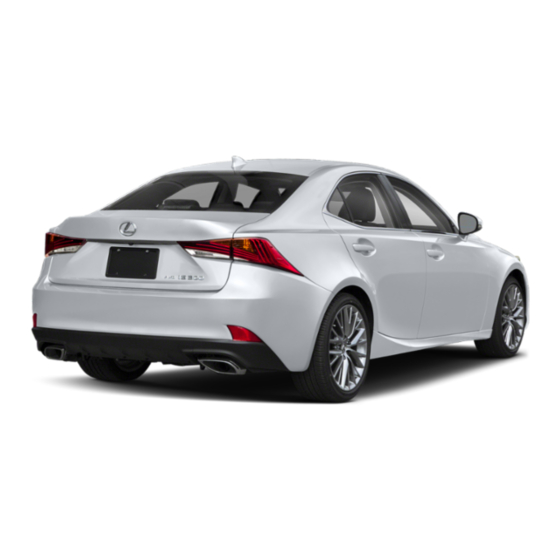
Lexus is300 2021 Manuals
Manuals and User Guides for Lexus is300 2021. We have 1 Lexus is300 2021 manual available for free PDF download: Service Manual
Lexus is300 2021 Service Manual (437 pages)
Brand: Lexus
|
Category: Automobile
|
Size: 14 MB
Table of Contents
-
Exterior11
-
-
-
For Safe Use21
-
Seat Belts24
-
SRS Airbags28
-
Unoccupied39
-
Exhaust Pipe40
-
When Parking40
-
Child Safety41
-
Booster Seat47
-
Booster Type48
-
Subscription56
-
Languages57
-
-
-
-
Indicators68
-
Menu Icons77
-
Distance79
-
History83
-
Card Key88
-
The Keys88
-
-
Trunk96
-
Trunk Light97
-
Front Seats106
-
Rear Seats107
-
Head Restraints111
-
Power Type113
-
Steering Wheel113
-
-
Power Windows118
-
-
Moon Roof120
-
-
4 Driving
123-
Before Driving124
-
When Braking128
-
Brake Function129
-
Trailer Towing132
-
Dinghy Towing133
-
-
Ai-Shift138
-
-
Snow Mode140
-
Parking Brake143
-
Brake Hold146
-
Headlight Switch149
-
-
-
Raindrop Sensor159
-
-
-
System Functions170
-
-
LTA Indicator185
-
-
Fine Adjustment196
-
Large Adjustment196
-
Approach Warning197
-
Brake Operation200
-
-
Display210
-
Types of Sensors210
-
-
-
Brake Control228
-
Weather230
-
-
Brake Assist238
-
Replacing Tires241
-
-
-
Remote Touch248
-
Touch Operation248
-
Double Tap249
-
Flick249
-
Center Display250
-
-
-
Sub Menu257
-
-
Seat Heaters261
-
Timer Function261
-
Seat Ventilator262
-
Seat Ventilators262
-
-
Trunk Features268
-
Armrest270
-
Assist Grips270
-
Coat Hooks270
-
-
-
Power Outlet271
-
Sun Visors271
-
Vanity Mirrors271
-
Rear Sunshade272
-
-
-
Bumpers281
-
-
-
Vehicle Interior288
-
Vehicle Exterior289
-
-
-
Hood293
-
Opening the Hood293
-
Battery301
-
Battery Exterior301
-
Checking Tires303
-
Tire Life303
-
Tires303
-
All Season Tires304
-
Snow Tires304
-
Tire Rotation305
-
Wheel Selection313
-
Wheels313
-
Wheel Bolts314
-
Removal Method315
-
Items to Prepare316
-
Headlight Aim320
-
Light Bulbs321
-
Bulb Locations322
-
-
-
While Towing332
-
Emergency Towing333
-
Audible Symptoms335
-
Visible Symptoms335
-
Slip Indicator343
-
Warning Buzzer346
-
Warning Messages346
-
Guide Pin355
-
-
-
Etc.)371
-
Seating Capacity372
-
Engine373
-
Engine Number373
-
Fuel Information382
-
Tire Information384
-
Tire Dimensions386
-
Tire Size386
-
Treadwear387
-
Customization394
-
Initialization404
-
-
9 For Owners
405-
Index417
-
What to Do if417
Advertisement
Advertisement
